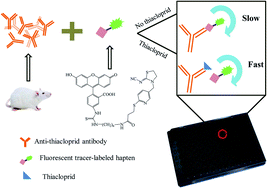A fluorescence polarization immunoassay for detection of thiacloprid in environmental and agricultural samples†
Abstract
As a widely used neonicotinoid insecticide, thiacloprid has been observed to pose a risk to honeybees and the endocrine system of mammals. So a detection method with high sensitivity, simple operation and high throughput is required. Based on this consideration, we prepared an anti-thiacloprid monoclonal antibody (mAb, C9) and developed a fluorescence polarization immunoassay (FPIA) for the detection of thiacloprid. After optimizing the length of spacer and reaction conditions, the 50% inhibition concentration (IC50), limit of detection (LOD) and linear range (IC20 ∼ IC80) of the FPIA are 15.34 ng mL−1, 2.43 ng mL−1 and 3.10–65.7 ng mL−1, respectively. Meanwhile, FPIA just requires 12 min to detect the pesticide with simple operation. Then the FPIA was used to detect the thiacloprid in spiked rice, soil, cucumber and tomato samples, and recoveries were in the range of 79.1%–105.3% with 3.7%–12.3% standard deviation. The FPIA also shows good correlation with high-performance liquid chromatography for the detection of thiacloprid in tomato samples.



 Please wait while we load your content...
Please wait while we load your content...